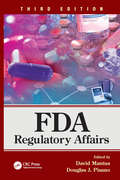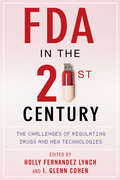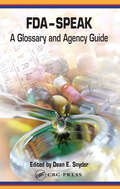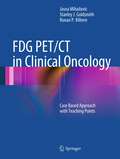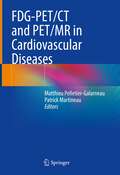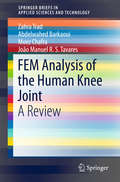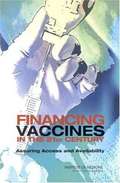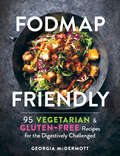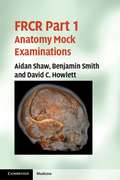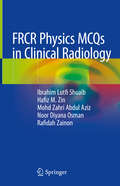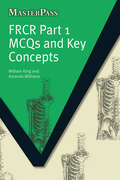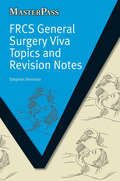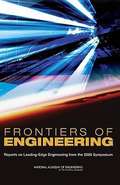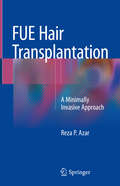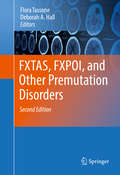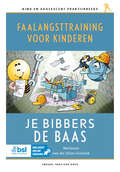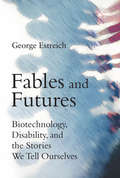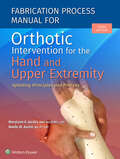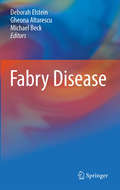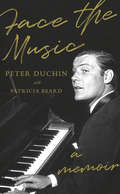- Table View
- List View
FDA Regulatory Affairs: Third Edition
by David Mantus Douglas J. PisanoFDA Regulatory Affairs is a roadmap to prescription drug, biologics, and medical device development in the United States. Written in plain English, the concise and jargon-free text demystifies the inner workings of the US Food and Drug Administration (FDA) and facilitates an understanding of how the agency operates with respect to compliance and product approval, including clinical trial exemptions, fast track status, advisory committee procedures, and more.The Third Edition of this highly successful publication: Examines the harmonization of the US Federal Food, Drug, and Cosmetic Act with international regulations on human drug, biologics and device development, research, manufacturing, and marketing Includes contributions from experts at organizations such as the FDA, National Institutes of Health (NIH), and PAREXEL Focuses on the new drug application (NDA) process, cGMPs, GCPs, quality system compliance, and corresponding documentation requirements Provides updates to the FDA Safety and Innovation Act (FDASIA), incorporating pediatric guidelines and follow-on biologics regulations from the 2012 Prescription Drug User Fee Act (PDUFA) V Explains current FDA inspection processes, enforcement options, and how to handle FDA meetings and required submissions Co-edited by an industry leader (Mantus) and a respected academic (Pisano), FDA Regulatory Affairs, Third Edition delivers a compilation of the selected US laws and regulations as well as a straightforward commentary on the FDA product approval process that’s broadly useful to both business and academia.
FDA in the Twenty-First Century: The Challenges of Regulating Drugs and New Technologies
by Cohen Lynch Holly Fernandez I. GlennIn its decades-long effort to assure the safety, efficacy, and security of medicines and other products, the Food and Drug Administration has struggled with issues of funding, proper associations with industry, and the balance between consumer choice and consumer protection. Today, these challenges are compounded by the pressures of globalization, the introduction of novel technologies, and fast-evolving threats to public health. With essays by leading scholars and government and private-industry experts, FDA in the Twenty-First Century addresses perennial and new problems and the improvements the agency can make to better serve the public good.The collection features essays on effective regulation in an era of globalization, consumer empowerment, and comparative effectiveness, as well as questions of data transparency, conflicts of interest, industry responsibility, and innovation policy, all with an emphasis on pharmaceuticals. The book also intervenes in the debate over off-label drug marketing and the proper role of the FDA before and after a drug goes on the market. Dealing honestly and thoroughly with the FDA's successes and failures, these essays rethink the structure, function, and future of the agency and the effect policy innovations may have on regulatory institutions abroad.
FDA-Speak: A Glossary and Agency Guide
by Dean E. SnyderOften thought of as a subdialect of American "governmentese," FDA-Speak is a language unique to healthcare regulators and those regulated. If you have any involvement with the US Food and Drug Administration, or if they have involvement with you, you need to speak the language. This revised and updated edition of FDA-Speak retains the original easy
FDG PET/CT in Clinical Oncology
by Stanley J. Goldsmith Jasna Mihailovic Ronan P. KilleenFDG PET/CT has rapidly emerged as an invaluable combined imaging modality that provides both anatomic and functional information. This book, comprising a collection of images from oncology cases, is organized according to the role of FDG PET/CT in the evaluation and management of oncology patients, and only secondarily by organ or tumor entity. In this way, it reflects the issues that clinicians actually address, namely: identification of an unknown or unsuspected primary; determination of the extent of disease; evaluation of response to therapy; and surveillance after response, i.e., detection of recurrent disease. In total, 100 cases involving different primary tumors are presented to illustrate findings in these different circumstances. FDG PET/CT in Clinical Oncology will be of great value to all newcomers to this field, whether medical students, radiology, nuclear medicine, or oncology fellows, or practicing physicians.
FDG-PET/CT and PET/MR in Cardiovascular Diseases
by Matthieu Pelletier-Galarneau Patrick MartineauThis book is a clinically oriented, up-to-date, and in-depth review of the various applications of FDG-PET/CT and PET/MR in cardiovascular diseases with emphasis on the current available evidence. Positron emission tomography (PET) imaging with fluorodeoxyglucose (FDG) has seen increased applications in cardiovascular diseases over the last decades. Its utility is already established in a wide range of conditions, including myocardial viability imaging, assessment of inflammatory diseases such as sarcoidosis and vasculitis, as well as imaging of infectious processes, such as infective endocarditis and cardiac implantable electronic device infection. In addition, there are several emerging indications such as the imaging of left ventricular assisting device infection and native valve endocarditis as well as new applications under investigation.The first section of the book reviews the technical basis of cardiovascular PET/CT and PET/MR imaging as well as cardiac metabolism. The following chapters each present specific pathologies, presenting epidemiology, pathophysiology, and diagnostic strategies, along with high quality clinical cases to support the discussion. The final chapter is a review of 15 interesting and clinically relevant cases.This is an ideal guide for nuclear medicine physicians, cardiologists, radiologists, residents, post-graduate fellows, and technologists.
FEM Analysis of the Human Knee Joint: A Review (SpringerBriefs in Applied Sciences and Technology)
by João Manuel R.S. Tavares Zahra Trad Abdelwahed Barkaoui Moez ChafraIn recent years, numerous scientific investigations have studied the anatomical, biomechanical and functional role of structures involved in the human knee joint. The Finite Element Method (FEM) has been seen as an interesting tool to study and simulate biosystems. It has been extensively used to analyse the knee joint and various types of knee diseases and rehabilitation procedures such as the High Tibial Osteotomy (HTO). This work presents a review on FEM analysis of the human knee joint and HTO knee surgery, and discusses how adequate this computational tool is for this type of biomedical applications. Hence, various studies addressing the knee joint based on Finite Element Analysis (FEA) are reviewed, and an overview of clinical and biomechanical studies on the optimization of the correction angle of the postoperative knee surgery is provided.
FINANCING VACCINES IN THE 21ST CENTURY: Assuring Access and Availability
by Committee on the Evaluation of Vaccine Purchase Financing in the United StatesThe national immunization system has achieved high levels of immunization, particularly for children. However, this system faces difficult challenges for the future. Significant disparities remain in assuring access to recommended vaccines across geographic and demographic populations. These disparities result, in part, from fragmented public–private financing in which a large number of children and adults face limited access to immunization services. Access for adults lags well behind that of children, and rates of immunizations for those who are especially vulnerable because of chronic health conditions such as diabetes or heart and lung disease, remain low. Financing Vaccines in the 21st Century: Assuring Access and Availability addresses these challenges by proposing new strategies for assuring access to vaccines and sustaining the supply of current and future vaccines. The book recommends changes to the Advisory Committee on Immunization Practices (ACIP)-the entity that currently recommends vaccines-and calls for a series of public meetings, a post-implementation evaluation study, and development of a research agenda to facilitate implementation of the plan.
FND Stories: Personal and Professional Experiences of Functional Neurological Disorder
by Gregg H. Rawlings, Markus Reuber, Jon Stone and Maxanne McCormickFunctional Neurological Disorder (FND) is one of the most common diagnoses among patients referred to neurology clinics, but is still misunderstood and under-recognised by medical professionals and the public. This vital book brings together the voices of healthcare professionals and people living with FND across the world. Experts in neurology provide a clear, evidence-based explanation of FND as an introduction, laying the foundation for the personal stories of people with FND and the professionals involved in their care. From testing and diagnosis to dealing with stigma and coping with changing symptoms, each chapter delves into the realities of life with FND from the perspective of lived experience. FND can be an isolating condition. The life stories in this book will help you to make sense of living with FND and tackle its challenges alongside others with the condition.
FODMAP Friendly: 95 Vegetarian And Gluten-free Recipes For The Digestively Challenged
by Georgia McDermottThis is the low-FODMAP cookbook vegetarians have been waiting for. It’s tough when the foods you love don’t love you back. If you’re dealing with digestive issues, cutting out high-FODMAP foods can bring relief—but it’s hard to say goodbye to wheat, dairy, and many fruits and veggies. And if you’re vegetarian or vegan and going low-FODMAP? It can be even harder to fill your plate! Georgia McDermott comes to the rescue in FODMAP Friendly, with 95 vegetarian, vegan-friendly, and gluten-free recipes for the digestively challenged. Her delicious, low- to no-FODMAP fare covers all the bases: Lighter meals and breakfasts, like Grain-Free Olive Oil Granola and Roasted Pepper and Halloumi Shakshuka Hearty dinners, from Tempeh Chili to Pepper, Pesto, and Goat Cheese Galette Delectable desserts—Pavlova with Roasted Lemony Strawberries, anyone? Festive food and drinks for a crowd, including Salted Honey and Sage Baked Camembert and Passion Fruit Caipirinhas FODMAP sensitivity varies from person to person, so Georgia includes a wealth of suggestions for exploring what does and doesn’t work for you. Onion and garlic don’t bother you? Add them! The thought of tomatoes turns you off? Don’t eat them! Living with IBS, Crohn’s disease, colitis, SIBO—you name it—shouldn’t mean needlessly missing out on the flavors you crave. This is low-FODMAP eating—made friendly for everyone.
FOOD INSECURITY and Hunger in the United States: AN ASSESSMENT OF THE MEASURE
by National Research Council of the National AcademiesThe National Academies Press (NAP)--publisher for the National Academies--publishes more than 200 books a year offering the most authoritative views, definitive information, and groundbreaking recommendations on a wide range of topics in science, engineering, and health. Our books are unique in that they are authored by the nation's leading experts in every scientific field.
FRCR Part 1 Anatomy Mock Examinations
by Benjamin Smith David C. Howlett Aidan ShawFRCR Part 1 Anatomy Mock MCQ Examinations provides essential practice for the new anatomy examination introduced by the Royal College of Radiologists. Written according to the syllabus set by the Royal College, each mock examination is laid out and structured in the same way as the actual papers, ensuring users gain familiarity with both the content and the style. Containing 10 mock examinations and 200 high quality MRI, CT, ultrasound, fluoroscopy, angiography and plain film images, all anatomical areas are covered, including normal variants and paediatric cases. By the end of the book, readers will have encountered every imaging modality and the majority of cases covered in the exam itself. Written by specialist registrars and a highly experienced radiology consultant and Fellowship examiner, FRCR Part 1 Anatomy Mock MCQ Examinations is the must-have revision tool for all Part 1 FRCR candidates.
FRCR Physics MCQs in Clinical Radiology
by Ibrahim Lutfi Shuaib Hafiz M. Zin Mohd Zahri Aziz Noor Diyana Osman Rafidah ZainonThis book offers a collection of specimen multiple choice questions (MCQs) for the first FRCR examination in clinical radiology that is for the physics module. It includes questions arranged in nine sets of 40 MCQs following the examination format. Additionally, chapters cover explanation to some of the answers for better understanding of the topics. The book covers updated syllabus of Royal College of Radiology (RCR), UK on scientific basis of medical imaging, including topics in molecular imaging. Each chapter with a practice set comprises of questions arranged in the order of the syllabus of the examination, starting from the basis of medical imaging and radiation physics to the principles of specific modalities and safety issues. This book offers assistance to candidates preparing for the first FRCR examination, clinical radiology trainees, and radiology and nuclear medicine postgraduate students.
FRCR: Pt. 1 (MasterPass)
by William King Amanda WilliamsThis concise and completely up-to-date study guide bridges the gap between a physics textbook and a self-test format exam aid. It comprehensively covers all the areas examined in the FRCR part 1, and by focusing on understanding the key concepts, rather than simply being able to answer questions correctly, this guide adopts a comprehensive, wide-ranging approach. It includes the latest updated radiation safety legislation (IR(ME)(A)R), and all information has been checked by a medical physicist as well as radiologists. The unique format features self-test MCQs with correct answers and associated key concepts. Test yourself over an entire topic, then check your answers at the back of the book. If you were not successful, you will not only be able to find the correct answers, you will understand where you have gone wrong. This book is highly recommended for candidates for the Fellowship of the Royal College of Radiologists (FRCR) part 1 examination.
FRCS General Surgery Viva Topics and Revision Notes (MasterPass)
by Stephen BrennanWhat are the indications for necrosectomy? How you perform an EUA for acute peri-anal sepsis? What do you understand by the term Early Goal-Directed Therapy (EGDT)? Remember: this is a consultant's exam, and giving a range of options is not good enough. You must tell the examiner what you as a consultant are going to do. The FRCS is a uniquely challenging prospect; highly detailed, wide-ranging and encompassing both theory and practice. Preparation for this exam can be very difficult, and resources tailored to it are scarce. As the consolidated notes of a recent successful candidate, this book is an essential resource when preparing for the viva. The wide variety of questions require you to define, diagnose or choose between treatment options, while MCQs and SBAs help you to objectively evaluate your progress - a unique supplement to your study plan. Answers provided are comprised of an invaluable combination of detailed written answers and lists that will remind you of key points and help you structure your preparation.
FRONTIERS OF ENGINEERING: Reports on Leading-Edge Engineering from the 2008 Symposium
by National Academy of Enegineering National of the National AcademiesEvery year at the U.S. Frontiers of Engineering Symposium, 100 of this country's best and brightest engineers, ages 30 to 45, have an opportunity to learn from their peers about pioneering work being done in many areas of engineering. The symposium gives early career engineers working in academia, industry, and government in many different engineering disciplines an opportunity to make contacts with and learn from individuals they would not meet in the usual round of professional meetings. This networking may lead to collaborative work and facilitate the transfer of new techniques and approaches. It is hoped that the exchange of information on current developments in many fields of engineering will lead to insights that may be applicable in specific disciplines and thereby build U.S. innovative capacity. Different topics are covered each year, and, with a few exceptions, different individuals participate. The four general topics covered at the 2008 meeting were: drug delivery systems, emerging nanoelectronic devices, cognitive engineering, and countering the proliferation of weapons of mass destruction. The intent of this book is to convey the excitement of this unique meeting and to highlight cutting-edge developments in engineering research and technical work.
FUE Hair Transplantation: A Minimally Invasive Approach
by Reza P. AzarThis book provides a comprehensive overview of hair transplantation using the Follicle Unit Extraction method, and is the translation of the successful German edition. Following a brief introduction to the topic and explaining key terms used in hair surgery, it discusses one of the most common reasons for hair loss - androgenic alopecia in men and women. The main body then describes the surgical procedure for the Follicle Unit Extraction (FUE) method, including prerequisites for donor and recipient sites, and postoperative care. The result of this minimally invasive procedure are detailed in a wealth of high-quality pictures. The punch and the FUT technique are highlighted as sampling methods. Rounding off the coverage of this highly interesting topic, the book summarizes the latest findings and offers an outlook on further developments.This book offers a valuable guide for all plastic surgeons and dermatologists interested in performing this technique at their practices.
FXTAS, FXPOI, and Other Premutation Disorders
by Flora Tassone Deborah A. HallThis book should serve as a resource for professionals in all fields regarding diagnosis, management, and counseling of patients with FXTAS, FXPOI and their families, as well as presenting the molecular basis for disease that may lead to the identification of new markers to predict disease risk and eventually lead to target treatments. The book will present information on all aspects of FXTAS, FXPOI and other premutation disorders including clinical features and current supportive management, radiological, psychological, and pathological findings, genotype-phenotype relationships, animal models and basic molecular mechanisms. Genetic counseling issues are also discussed.
Faalangsttraining voor kinderen: Je bibbers de baas (Kind en adolescent praktijkreeks)
by Marianne van der Zalm-GrisnichDit boek is een cognitief gedragstherapeutisch (groeps)behandelprotocol waarmee therapeuten kinderen tussen de 9 en 12 jaar leren met hun faalangst om te gaan en deze te verminderen. Dit protocol is door het NJI erkend als ‘goed onderbouwde jeugdinterventie’ en geschreven voor orthopedagogen, kinderpsychologen, gedragstherapeuten en psychotherapeuten. Deze tweede, herziene versie van Je bibbers de baas combineert cognitieve gedragstherapie met ontspanningstechnieken, psycho-educatie en onderdelen uit de Acceptance and Commitment Therapy. Ook komt de rol van mindset aan bod. Verder zijn energizers toegevoegd en is er aandacht voor terugvalpreventie. Ook bevat de handleiding nu een hoofdstuk over gebruik in bijzondere situaties, zoals het voortgezet onderwijs, klassikaal gebruik, individuele inzet en gebruik bij kinderen met ontwikkelingsproblemen. Het protocol bestaat uit tien kinderbijeenkomsten en twee ouder- en leerkrachtbijeenkomsten. Kinderen werken in hun eigen werkboek (apart verkrijgbaar). Voor ouders en leerkrachten is er een online werkboek. Deze en meer online materialen zijn toegankelijk met behulp van een code in de handleiding.
Fables and Futures: Biotechnology, Disability, and the Stories We Tell Ourselves (The\mit Press Ser.)
by George EstreichHow new biomedical technologies—from prenatal testing to gene-editing techniques—require us to imagine who counts as human and what it means to belong.From next-generation prenatal tests, to virtual children, to the genome-editing tool CRISPR-Cas9, new biotechnologies grant us unprecedented power to predict and shape future people. That power implies a question about belonging: which people, which variations, will we welcome? How will we square new biotech advances with the real but fragile gains for people with disabilities—especially when their voices are all but absent from the conversation?This book explores that conversation, the troubled territory where biotechnology and disability meet. In it, George Estreich—an award-winning poet and memoirist, and the father of a young woman with Down syndrome—delves into popular representations of cutting-edge biotech: websites advertising next-generation prenatal tests, feature articles on “three-parent IVF,” a scientist's memoir of constructing a semisynthetic cell, and more. As Estreich shows, each new application of biotechnology is accompanied by a persuasive story, one that minimizes downsides and promises enormous benefits. In this story, people with disabilities are both invisible and essential: a key promise of new technologies is that disability will be repaired or prevented.In chapters that blend personal narrative and scholarship, Estreich restores disability to our narratives of technology. He also considers broader themes: the place of people with disabilities in a world built for the able; the echoes of eugenic history in the genomic present; and the equation of intellect and human value. Examining the stories we tell ourselves, the fables already creating our futures, Estreich argues that, given biotech that can select and shape who we are, we need to imagine, as broadly as possible, what it means to belong.
Fabrication Process Manual for Orthotic Intervention for the Hand and Upper Extremity
by MaryLynn Jacobs Noelle AustinCompanion to the comprehensive hand therapy text, Orthotic Intervention for the Hand and Upper Extremity: Splinting Principles and Process This comprehensive manual is the perfect resource for use in the classroom, during labs, and in clinical practice for both occupational and physical therapists. Additionally, it is a great reference for those studying to become a Certified Hand Therapist (CHT). The Fabrication Process Manual complements the main text, Orthotic Intervention for the Hand and Upper Extremity: Splinting Principles and Process, and clearly presents step-by-step instructions for the fabrication of the orthoses as well as providing alternative orthotic treatment options. The various orthoses and techniques presented allow the therapist to tailor each orthosis for the specific patient.
Fabry Disease
by Michael Beck Deborah Elstein Gheona AltarescuFabry disease is an X-linked inborn error of metabolism wherein deficiency of a lysosomal enzyme results in systemic deposition of glycosphingolipids. Storage deposition, and hence pathological disease, occurs preferentially in renal glomerular and tubular epithelial cells, myocardial cells, heart valve fibrocytes, neurons of dorsal root ganglia, and in endothelial smooth muscle cells of blood vessels. Thus, Fabry disease is a multi-system disorder, albeit with considerable phenotypic heterogeneity in onset and in severity; however, it is progressive, exhibits extensive morbidity, and is life-threatening. Within the past two decades, there has been a radical change in the natural course Fabry disease by virtue of the availability of specific enzyme replacement therapy. Moreover, there has been a concerted effort to better understand the underlying pathology and equally to identify patients prior to the onset of irreversible end-organ damage. It is to be hoped that the future for patients with Fabry disease can be viewed with greater, albeit guarded, optimism. This state-of-the-art textbook attempts to bridge the span of pre-clinical studies, clinical finding, and management options in a readable but comprehensive manner for the medical practitioner as well as the interested non-medical reader.
Face Transplantation
by Juan P. Barret Veronica TomaselloThis book brings together all the relevant available science behind face transplants. It is comprehensive in its coverage, encompassing patient and donor evaluation, ethics, legal issues, psychological issues, types of transplant, surgical technique, issues relating to immunosuppression, follow-up protocols, and current outcomes. Facial transplantation, which allows the replacement of missing anatomy with a perfect match based on transplant medicine principles, has become the most striking innovation in plastic surgery of the twenty-first century as surgeons and scientists progress from reconstructive surgery to restorative surgery. A robust team approach is, however, necessary to produce safe and efficient outcomes, and numerous questions are arising, from technical issues to ethical dilemmas. The reader will discover in this volume all the information required in order to understand this new discipline and to be able to set up a program of facial transplantation.
Face the Music: A Memoir
by Peter Duchin Patricia BeardIn this poignant memoir, the internationally celebrated bandleader reflects on family, illness, grief, and a bygone era of glamour, contemplating not just his career but the history of midcentury music and nightlife—and the enormously important role that the bandstand played in his life. The internationally-famous bandleader Peter Duchin's six decades of performing have taken him to the most exclusive dance floors and concert halls in the world. He has played for presidents, kings, and queens, as well as for civil rights and cultural organizations. But in 2013, Duchin suffered a stroke that left him with limited use of his left hand, severely impacting his career. Days of recuperating from his stroke—and later from a critical case of Covid-19—inspired Duchin to reconsider his complicated past. His father, the legendary bandleader Eddy Duchin, died when Peter was twelve; his mother, Marjorie Oelrichs Duchin, died when he was just six days old. In the succeeding decades, Duchin would follow his father to become the epitome of mid-20th Century glamour. But it was only half a century later, in the aftermath of his sudden illnesses, that he began to see his mother and father not just as the parents he never had, but as the people he never got to know; and at the same time, to reconsider the milieu in which he has been both a symbol and a participant. More than a memoir, Face the Music offers a window into the era of debutantes and white-tie balls, when such events made national headlines. Duchin explores what &“glamour&” and &“society&” once meant, and what they mean now. With sincerity and humor, Face the Music offers a moving portrait of an extraordinary life, its disruptions, and revitalization.
Face to Face with Emotions in Health and Social Care
by Benjamin GrayThis book draws from the everyday experiences as well as the harsh realities confronting behavioral care providers on the frontline. The book recounts the stories and sometimes disturbing emotions of people whose lives have undergone sudden change or even drastic trauma; people whose feelings of comfort and safety have been shattered by exposure to illness, abuse, death and bereavement. The perspectives and experiences of nurses, social care staff, patients, children and families are at the core of understanding the importance, challenges and therapeutic vitality of emotions. The 55 individuals on the frontline who took part in the interviews on which this study is based discuss the emotions associated with care in mental health, pediatric oncology, AIDS/HIV, as well as child protection and abuse, racism, refugee exile, poverty, and social exclusion. Their bravery, openness, and ability to communicate and share their emotions make this book possible.
Face to Face with the Face: Working with the Face and the Cranial Nerves through Cranio-Sacral Integration
by Thomas Attlee R.C.S.T. Dr Granville Orthodontist L. D. S. R. C. S. E Lond Dr Wojciech TarnowskiPractical and clear, this comprehensive guide to cranio-sacral treatment of the face explains treatment approaches that can make a significant difference to persistent and intractable conditions, enabling profound transformation in quality of life through whole-person integration. The book explores the eyes, ears, nose, sinuses, mouth, teeth and jaw, and provides a practical means of resolving the multitude of conditions affecting these crucial areas in a gentle, non-invasive manner, utilising the body's inherent healing potential. It covers a wide range from persistent ear infections, dental disturbances, facial injury, sinusitis and trigeminal neuralgia, one of the most painful conditions known to the medical world, through to identifying hidden causes of migraine, autism and chronic fatigue and patterns of ill health arising from birth, early childhood and past trauma. Cranial nerve dysfunctions, including polyvagal disturbances, are also included. Hand positions and contacts are clearly presented with over 200 colour photographs and anatomical drawings. A comprehensive presentation of the potential cooperation between dentistry and cranio-sacral therapy is also provided, with contributions from two eminent dentists, providing much needed information on this growing field of integrative medicine. Essential reading in this rapidly expanding area of practice, the book is fully illustrated in colour.
